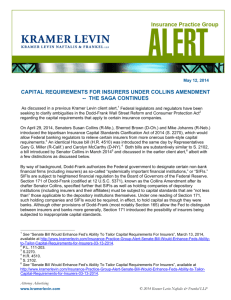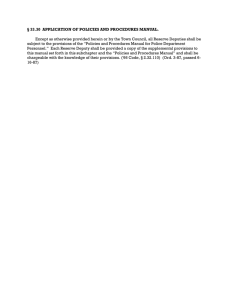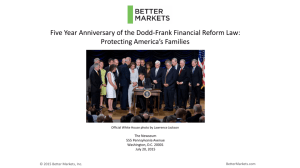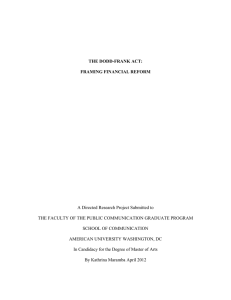Dodd-Frank Act Provisions Impacting Insurance Business (cont.)
advertisement
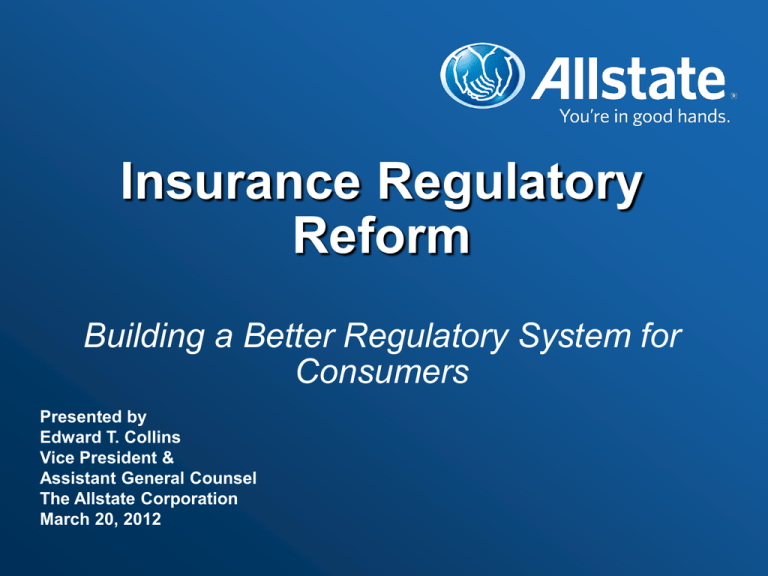
Insurance Regulatory Reform Building a Better Regulatory System for Consumers Presented by Edward T. Collins Vice President & Assistant General Counsel The Allstate Corporation March 20, 2012 In the midst of change…. Sweeping financial services regulatory reform was signed into law on July 21, 2010. What will final regulations look like? How will reform impact insurance? What will Federal Insurance Office do? 2 Impact of Dodd-Frank Act on Insurance Business The Dodd-Frank Wall Street Reform and Consumer Protection Act was signed into law by the President July 21, 2010. Focus now is on implementation; hundreds of new regulations to be promulgated before many of the provisions are implemented. Immediate impacts on insurance business currently appear to be minimal, but there are additional requirements and restrictions, particularly for insurers that own banks and publicly traded insurers. Intermediate and longer-term impact likely because of new Federal Insurance Office. 3 Dodd-Frank Act Provisions Impacting Insurance Business Systemic Risk Regulation The Financial Stability Oversight Council (“FSOC”) was created to monitor and address systemic risk and is chaired by the Treasury Secretary. Proposed certain criteria to designate financial institutions as systemically important (“SIFIs”). Designation as SIFI results in increased prudential standards, liquidity requirements, and government oversight. The proposed criteria could mean that a few large insurers may be designated as SIFIs. Resolution Authority Federal government is granted authority to unwind troubled financial services firms. Costs are to be borne first by shareholders and unsecured creditors and then, if necessary, additional funding via riskbased post-event assessments upon financial institutions, which could include insurers; proposal for pre-event funding removed prior to passage of bill. Authority to wind down non-SIFI designated insurance companies remains exclusively with the state guaranty fund system. 4 Dodd-Frank Act Provisions Impacting Insurance Business (cont.) Banking Regulation and Consolidation The Office of Thrift Supervision ("OTS") was merged into the Office of the Comptroller of the Currency (“OCC”) . The Fed will retain supervision of bank holding companies and state-chartered banks and become the supervisor of savings and loan holding companies which is what many insurance companies own. Under the new provisions, many insurer-owned banks will be regulated by the OCC, and holding companies will be regulated by the Fed. Capital Standards 5 Requirements for “Tier 1” capital for financial institutions are increased. Leverage requirements currently applicable to insured depository institutions will be applied to bank and thrift holding companies and SIFIs. Federal banking supervisors are also directed to develop capital requirements for all insured depository institutions, holding companies, and SIFIs. Dodd-Frank Act Provisions Impacting Insurance Business (cont.) The Volcker Rule New restrictions will be applicable to proprietary trading and participation in hedge funds and private equity funds for all FDIC-insured commercial banks and their affiliates and SIFIs. The Federal Reserve, FDIC, SEC, OCC, and CFTC are involved in the final rulemaking process. Comments on the proposed rule were due in February 2012. The Volcker Rule is set to go into effect in July, 2012, followed by a two-year phase-in period. 6 Dodd-Frank Act Provisions Impacting Insurance Business (cont.) Regulation of Derivatives New provisions are added to increase transparency for OTC derivatives and require centralized clearing and exchange trading for most derivatives. All derivatives transactions, whether or not they are cleared or exchange traded, will need to be reported. Capital and margin requirements will be increased, and the Commodity Futures Trading Commission (CFTC) and the SEC are developing rules for swap clearance and the definitions of swap dealers and major swap participants. Consumer Financial Products Protection The Consumer Financial Protection Bureau (CFPB) is created with authority to write consumer protection rules for firms offering consumer financial services or products. The business of insurance is excluded from the jurisdiction of the new agency but banking is included. President Obama recently appointed Richard Cordray as the Director of CFPB using controversial recess appointment despite Congressional opposition. 7 Dodd-Frank Act Provisions Impacting Insurance Business (cont.) Credit Rating Agency Reform (“CRA”) Established office of Credit Ratings to directly regulate CRAs. Required SEC to establish rules to improve internal CRA procedures and methodologies, reduce conflicts of interest, mandate more independence in corporate governance, and increase public disclosure. Attempted to increase CRA liability by eliminating Safe Harbor and lowering plaintiff pleading standards. Mandated removal of all reference to CRAs and their ratings from federal regulations. Federal Insurance Office (“FIO”) 8 The FIO is created within Treasury to monitor the insurance industry and coordinate international insurance issues. The Office is also required to study the insurance market and recommend improvements to the system of insurance regulation. Financial Services Reform Had to Include the Insurance Industry The AIG Bailout: The most costly corporate collapse to date was not a bank, but an insurance company. The federal government loaned $180 billion to AIG. Regulatory Gaps Need to be Closed: No single regulator had a complete picture of or authority to regulate the activities of AIG. Dodd-Frank Act imposes new federal regulation on insurers. 9 Today’s Insurance Regulatory Scheme 51 Jurisdictions/Regulators • 12,000 Regulations • 50,000 Insurance Laws 52 Volumes/ 46,124 Pages of Insurance Laws • 8,700 Related Regulations 33 Volumes/ 12,441 Pages of Related Regulations • State Case Law 10 53 Volumes/ 61,533 Pages of Regulations • 2,300 Insurance Bulletins 17 Volumes/ 1,802 Pages of Insurance Bulletins • 2,000 Circular Letters 10 Volumes/ 8,500 Pages of Circular Letters • Litigation 11 Shortcomings of Current System for National Carriers & Agents Lack of Uniformity and Consistency Regulatory Redundancies Limited Authority Regulatory Gaps Cannot Make Agreements with Foreign Authorities on Behalf of U.S. 12 Agent Licensing Cost of Compliance Pricing & Underwriting Controls Product/Form Controls Lack of Portability for Consumer Why not Focus on State Regulation Reform? Regulator Position on Uniform Insurance Regulation: “The Commissioners are now fully prepared to go before their various legislative committees with recommendations for a system of insurance law which shall be the same in all States, not reciprocal but identical, not retaliatory but uniform.” 13 Why not Focus on State Regulation Reform? Regulator Position on Uniform Insurance Regulation: “The Commissioners are now fully prepared to go before their various legislative committees with recommendations for a system of insurance law which shall be the same in all States, not reciprocal but identical, not retaliatory but uniform.” - NY Insurance Commissioner George W. Miller, 1871 14 Allstate’s Stand Regulatory Goals: Inform and empower consumers about the risks they face and the means to manage those risks Promote competitive market and consumer choice Facilitate availability and affordability Ensure that insurers are financially strong Improve regulatory compliance, customer service, and operational excellence Encourage insurers to innovate Reduce the cost of regulatory management to government, and, consequently taxpayers 15 Allstate’s Stand FIO Priorities: Maximize uniformity, consistency and the use of best practices in the regulatory system Minimize duplicative regulation of insurance, and coordinate and streamline regulatory processes and data requests Consolidate U.S. leadership and the representation on international insurance matters through the FIO 16 Allstate’s Stand Let’s all work together to improve the system for consumers Need to modernize the system More uniformity and best practices would benefit everyone Creation of the FIO is a good step forward 17 Questions 18
